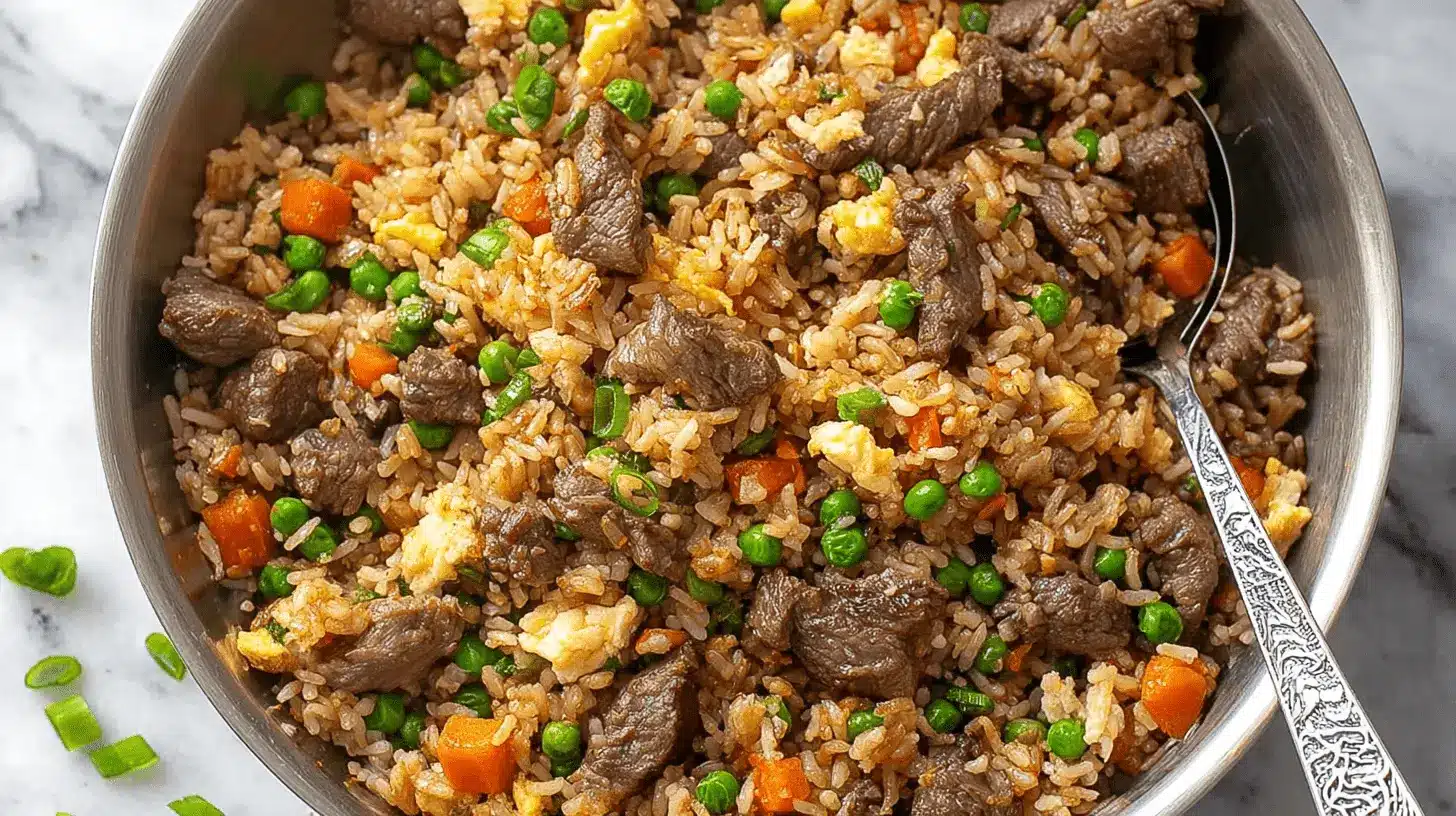Table of Contents
There’s something incredibly comforting about a plate of fried rice, isn’t there? I have fond memories of watching my grandmother whip up fried rice in our kitchen. The sizzling sounds, the tantalizing aromas, and the vibrant colors made it one of my favorite meals. Today, I’m excited to share my take on this classic dish—beef fried rice. It’s not just delicious but also easy to make at home, and it only takes about 30 to 40 minutes from start to finish.
When you make beef fried rice yourself, you unlock a whole new level of flavor and satisfaction. It’s a fantastic feeling to create something so flavorful and comforting from scratch.
Why You’ll Love This Beef Fried Rice
Here’s why you should definitely consider making this beef fried rice at home:
- Better Taste: You can adjust flavors and seasoning to suit your personal preference, ensuring a dish that’s truly yours.
- Cost-Effective: This recipe uses simple, affordable ingredients. You’ll find that making it at home is much cheaper than ordering takeout.
- Customizable: Feel free to add whatever vegetables you have on hand or tweak the meat to fit your taste.
- Healthier Options: Since you control the ingredients, you can make healthier choices, like using less oil or adding more veggies.
The History & Types of Beef Fried Rice
Fried rice has a fascinating history, believed to have originated in China during the Sui Dynasty. It quickly became popular for its ability to use leftover ingredients, making it a go-to for busy families. In many cultures, fried rice has evolved, with distinct regional variations that reflect local ingredients and flavors. From authentic Asian versions rich with umami to Westernized takeout styles loaded with sauces, beef fried rice is a versatile dish enjoyed worldwide.
Achieving “Wok Hei” at Home
If you’ve ever had authentic fried rice, you’ve likely experienced the elusive “wok hei.” This term refers to the smoky, charred flavor that comes from cooking in a hot wok. To achieve wok hei at home, I recommend using a well-seasoned wok or a large skillet. Cook in batches, maintaining high heat, and try the “broth around the perimeter” technique. Adding a splash of broth along the edges of the cooker as you stir-fry can help you get that authentic flavor.
Key Ingredients for the Best Beef Fried Rice
Each ingredient plays a crucial role in building flavor and texture in this beef fried rice.
The Beef
For the best results, I suggest using flank steak, sirloin, or even ground beef. Properly cutting the beef into bite-sized pieces allows it to cook evenly.
Perfect Rice for Fried Rice
Day-old rice is generally recommended as it’s drier and less sticky, yielding better results. If you’re cooking fresh rice, use less water and cool it quickly to prevent excess moisture.
The Sauce
A fantastic fried rice sauce typically consists of soy sauce, dark soy sauce, sesame oil, sugar, MSG, and white pepper. Each component adds depth and balance to the overall flavor profile.
Other Essential Ingredients
Other key ingredients include eggs for richness, onions for sweetness, peas for freshness, scallions for a pop of color, canola oil for frying, beef broth for extra flavor, and apple cider vinegar for a tangy kick.
Beef Fried Rice Ingredients
- 10 ounces flank steak (285g, cut into bite-sized pieces)
- ¼ teaspoon salt
- 1 tablespoon water
- 1/8 teaspoon baking soda (optional, but good for tougher cuts of meat)
- 1 teaspoon dark soy sauce (mushroom flavored preferred)
- 1 teaspoon cornstarch
- 1 teaspoon oil
- 1 tablespoon hot water
- ¼ teaspoon sugar
- ½ teaspoon sesame oil
- 1½ tablespoons soy sauce
- 2 teaspoons dark soy sauce
- ½ teaspoon MSG (totally optional!)
- Fresh ground white pepper
- 5 cups cooked rice
- 3 tablespoons canola oil (divided)
- 2 eggs (beaten)
- 1 medium onion (diced)
- ¾ cup peas
- 1 scallion (chopped)
- 1 tablespoon beef broth
- 1 teaspoon apple cider vinegar
How to Make Beef Fried Rice: Step-by-Step Instructions
- First, combine the beef, salt, water, baking soda, dark soy sauce, cornstarch, and oil in a bowl and stir until well-incorporated. Set aside. (We added a bit of water to marinate the beef, which generally is a no-no for beef…but for this fried rice dish, it keeps the small morsels of beef juicy and tender!)
- Next, combine the hot water, sugar, sesame oil, soy sauces, MSG (if using), and white pepper in a small bowl. This is the sauce that you’ll be adding to the rice, and it’s much easier to have it combined and ready to go before you start cooking.
- Take your cooked rice and fluff it with a fork or your hands (you can rinse your hands in cold water if the rice starts sticking to them). If you are using cold leftover rice, try to break up the clumps as best as possible.
- Heat your wok over medium-high heat, add 1 tablespoon of oil and the eggs, and scramble them until just cooked. You can start scooping them up when they look like they are almost done. Transfer them back into the same bowl you mixed them in and set aside. They will continue to cook in the bowl, and you will cook them again in the rice.
- Heat the wok until just smoking and spread 1 tablespoon of oil around your wok. Add the marinated beef in one layer and let it sear for 20 seconds. Next, stir-fry the beef until about 70% done. Transfer the beef back to the marinade bowl and set aside.
- With the wok over medium-high heat, add the last tablespoon of oil and sauté the onions until translucent, about 2 minutes. Add the rice, using a metal spatula to flatten and break up any large clumps. If the rice is cold from the refrigerator, continue stir-frying until the rice is warmed up, about 5 minutes. Sprinkling a little water on large clumps of rice will help break them up more easily.
- Once the rice is warmed through, add the sauce mixture. Stir the rice with a scooping motion until the grains are evenly coated with sauce. The rice should be completely hot by now. Next, add the beef and any juices from the bowl you set aside earlier, and stir-fry for another minute.
- Add the eggs, breaking up any large clumps, along with the peas and scallions. Continue stir-frying for another 30 seconds. Push the rice into the middle of the wok to allow the perimeter to heat up. After about 20 seconds, pour 1 tablespoon of beef broth and 1 teaspoon apple cider vinegar around the perimeter of the wok. Stir-fry for another 20 seconds. Adding this mixture using this method gives the dish a little extra wok hei! At this point, taste the rice to see if it needs a little more salt, soy sauce, or white pepper and season accordingly.
- Serve immediately, and, if you’re like us, don’t forget some homemade chili oil!
Beef Marinade & Tenderizing Tips
The marinade serves to enhance the flavor and tenderness of the beef. One key ingredient is baking soda, which works wonders in tenderizing meat by raising the pH level, making it less acidic and allowing it to absorb a bit more moisture. This results in a more succulent texture and flavor. Additional tips for tenderizing include marinating meats for longer periods or using ingredients like yogurt or pineapple juice.
Sauce Composition and Flavor Balance
Each component in the sauce is crucial for building the flavor profile. Soy sauce delivers saltiness and depth; dark soy sauce contributes richness and color. Sesame oil adds nuttiness, sugar balances out savory elements, MSG enhances umami, and white pepper contributes warmth. Adjusting these ingredients allows you to personalize the sauce according to your taste.
Cooking Stages and High Heat Technique
Cooking in stages helps to keep each ingredient at its optimal texture and prevents overcrowding. By maintaining high heat, you ensure a nice char and prevent the ingredients from steaming. This also ties back to achieving that fantastic “wok hei” flavor.
Vegetable Customization
Don’t hesitate to swap in or add various vegetables! Here’s a quick list of options:
- Fresh: Bell peppers, carrots, or broccoli. Dice or slice them thinly beforehand.
- Frozen: Green beans, corn, or mixed vegetables. Add them towards the onion sautéing stage so they have time to cook through.
Serving Suggestions & Pairings
Beef fried rice pairs wonderfully with dishes like spring rolls, hot and sour soup, or a flavorful side dish such as steamed vegetables. They complement the dish without overwhelming it and add variety to your meal.
Storing and Reheating Beef Fried Rice
To store leftover beef fried rice, cool it down quickly and transfer it to an airtight container. It should keep well in the refrigerator for about 3 to 4 days.
Advanced Storage & Reheating
When reheating, the method matters for maintaining texture:
- Microwave: Quick and easy; just make sure to add a little water to keep it from drying out.
- Stovetop: This can give you a better texture; add a splash of water to help steam it back to life.
- Air Fryer: Great for getting it crispy again; just a few minutes at 350°F (175°C) should do.
Troubleshooting Common Beef Fried Rice Problems
Here are some common issues and their fixes:
- Mushy Rice: Ensure your rice is cooled and dried out before frying; avoid overcrowding the pan.
- Tough Beef: Tenderize with a proper marinade and don’t overcook.
- Bland Flavor: Adjust seasoning and add a bit more sauce.
- Rice Sticking: Use enough oil and ensure your wok is properly heated.
Dietary Adjustments
Making this dish gluten-free is easy—simply use gluten-free soy sauce. For a dairy-free option, everything in this recipe is dairy-free by default. To make it healthier, consider using less sodium soy sauce and adding more vegetables.
Variations and Substitutions
| Ingredient | Substitution Options |
|---|---|
| Flank Steak | Sirloin, ground beef, chicken, pork, shrimp, tofu |
| Rice | Brown rice, quinoa, cauliflower rice |
| Soy Sauce | Tamari (for gluten-free), coconut aminos |
| Dark Soy Sauce | Molasses |
| Peas | Green beans, corn, carrots |
| Beef Broth | Chicken broth, vegetable broth |
| Apple Cider Vinegar | White vinegar, rice vinegar |
Frequently Asked Questions
Can I use frozen rice?
Yes, you can! Just ensure it’s defrosted and fluffed before adding it to the wok to avoid clumping.
Can I make this recipe ahead of time?
Absolutely! Just prepare the ingredients and cook them right before serving for the best texture and flavor.
Is beef fried rice healthy?
It can be, especially when you control the ingredients. You can use leaner cuts of beef, add plenty of vegetables, and control sodium levels.
Conclusion
Now that you know how to make delicious beef fried rice, I encourage you to give it a try. It’s a fantastic dish that not only delivers on flavor but also allows you to express your creativity in the kitchen. I can’t wait to hear how it turns out for you. Don’t forget to leave a comment below and share your favorite additions to fried rice—let’s keep the conversation going!
Tantalizing Beef Fried Rice Recipe
Equipment
- wok
- Large skillet
- Small Bowl
- metal spatula
Ingredients
- 10 ounce flank steak 285g, cut into bite-sized pieces
- ¼ teaspoon salt
- 1 tablespoon water
- 1/8 teaspoon baking soda optional, but good for tougher cuts of meat
- 1 teaspoon dark soy sauce mushroom flavored preferred
- 1 teaspoon cornstarch
- 1 teaspoon oil
- 1 tablespoon hot water
- ¼ teaspoon sugar
- ½ teaspoon sesame oil
- 1½ tablespoons soy sauce
- 2 teaspoons dark soy sauce
- ½ teaspoon MSG totally optional!
- Fresh ground white pepper
- 5 cups cooked rice
- 3 tablespoons canola oil divided
- 2 eggs beaten
- 1 medium onion diced
- ¾ cup peas
- 1 scallion chopped
- 1 tablespoon beef broth
- 1 teaspoon apple cider vinegar
Instructions
- First, combine the beef, salt, water, baking soda, dark soy sauce, cornstarch, and oil in a bowl and stir until well-incorporated. Set aside. (We added a bit of water to marinate the beef, which generally is a no-no for beef…but for this fried rice dish, it keeps the small morsels of beef juicy and tender!)
- Next, combine the hot water, sugar, sesame oil, soy sauces, MSG (if using), and white pepper in a small bowl. This is the sauce that you’ll be adding to the rice, and it’s much easier to have it combined and ready to go before you start cooking.
- Take your cooked rice and fluff it with a fork or with your hands (you can rinse your hands in cold water if the rice starts sticking to them). If you are using cold leftover rice, try to break up the clumps as best as possible.
- Heat your wok over medium high heat, add 1 tablespoon of oil and the eggs, and scramble them until just cooked. You can start scooping them up when they look like they are almost done. Transfer them back into the same bowl you mixed them in and set aside. They will continue to cook in the bowl and you will cook them again in the rice.
- Heat the wok until just smoking and spread 1 tablespoon oil around your wok. Add the marinated beef in one layer, and let sear for 20 seconds. Next, stir fry the beef until about 70% done. Transfer the beef back to the marinade bowl, and set aside.
- With the wok over medium high heat, add the last tablespoon of oil, and sauté the onions until translucent, about 2 minutes. Add the rice, using a metal spatula to flatten out and break up any large clumps. If the rice is cold from the refrigerator, continue stir-frying until the rice is warmed up, about 5 minutes. Also, sprinkling a little water on large clumps of rice will help break them up more easily.
- Once the rice is warmed through, add the sauce mixture. Stir the rice with a scooping motion until the grains are evenly coated with sauce. The rice should be completely hot by now. Next, add the beef and any juices from the bowl you set aside earlier, and stir fry for another minute.
- Add the eggs, breaking up any large clumps, peas, and the scallions. Continue stir-frying for another 30 seconds. Push the rice into the middle of the wok to let the perimeter of the wok heat up. After about 20 seconds, pour 1 tablespoon of beef broth and 1 teaspoon apple cider vinegar around the perimeter of the wok. Stir-fry for another 20 seconds. Adding this mixture using this method gives the dish a little extra wok hei! At this point, taste the rice to see if it needs a little more salt, soy sauce, or white pepper and season accordingly.
- Serve immediately, and, if you’re like us, don’t forget some homemade chili oil!
Notes
Printable Recipe Card
Want just the essential recipe details without scrolling through the article? Get our printable recipe card with just the ingredients and instructions.

A 48-year-old contributing writer based in New York City. He is known for his insightful articles on American cuisine and food culture. With a lifelong passion for cooking and storytelling, David began his journey in the culinary world as a chef before transitioning to writing. He has contributed to various food magazines and blogs, sharing his experiences, recipes, and culinary tips, inspiring home cooks and food enthusiasts alike. Through his engaging writing style, David explores the rich tapestry of American cuisine, celebrating its diversity while encouraging readers to experiment in their own kitchens.



